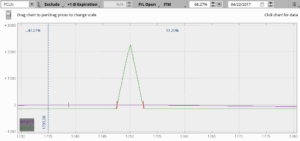Butterflies are the most exciting and versatile ways to trade options. The returns can be very high for a small investment. A handful of well-chosen stocks can give you consistent profits. A few traders have butterfly "farms"; all they do is trade butterfly spreads. In fact, you can be wrong and still make money! Like all trades, however, you can also lose your entire investment--something that beginning traders do all the time! The secret to successfully trading is to minimize costs and maximize both probability and profitability of each trade.
The Learning Curve
Butterflies take many steps to learn and manage well. Like real butterflies, they are hard to pin down, and tend to flit from flower to flower -- strike to strike -- before landing on one for an extended period. This course will guide you step-by-step in understanding and managing butterflies profitably. The techniques revealed here will help you net butterfly spreads and bring in profits like no other.
The Basics of Butterfly Spreads
What is a Butterfly? Investopedia says, "Butterfly spreads use four option contracts with the same expiration but three different strike prices to create a range of prices the strategy can profit from. The trader sells two option contracts at the middle strike price and buys one option contract at a lower strike price and one option contract at a higher strike price." (Read more about the Butterfly Spread.)
So we end up with a fat body (2 contracts) and two thin wings (1 contract each).  The body contains twice as many contracts as each wing. Here is a typical butterfly on PCLN. The "short" strike (20 contracts) of 1750 is in the middle, with protections or longs at 1755 (10 contracts) and 1745 (10 contracts).
The body contains twice as many contracts as each wing. Here is a typical butterfly on PCLN. The "short" strike (20 contracts) of 1750 is in the middle, with protections or longs at 1755 (10 contracts) and 1745 (10 contracts).
Butterfly spreads can be different widths. The wider the wings, the more expensive they are. As a rule, we prefer top trade them on stocks that have narrow strikes (e.g. $2.50 or $1.0 wide rather than $10 or $20. The more expensive the stock, the more money you can make. As a result, traders prefer stocks like PCLN, AMZN, GOOGL for this trade.
How does the Butterfly make money? To place this spread, I "buy" it for a fixed price and then sell at a higher price. Think of a butterfly as a chrysalis in a cocoon, waiting for the right time to "pop" out with a beautiful winged creature. This occurs as time decays and the stock remains at the current price. Both can occur best on the final day of expiration, when the "sold" strike is crushed by time decay. In the Priceline example, profit for 10 contracts could reach as high about $2,000 if the stock expires close to the 1750 strike. To harvest this profit, I simply sell the entire butterfly for more than I paid for it. (You can also sell butterflies for a profit and buy them back cheaper, for a profit. More on that later.)
What kind of market is best for butterflies? 
It is very difficult for a butterfly to land on a bouncing branch. But in a stable market, when stock prices change little, it would be very easy to predict where prices may be at expiration. This would be ideal, of course! You could simply place a butterfly at the right strike and be guaranteed a profit. But in reality, prices move and we need to be satisfied with a range of strikes. Its always a guess, but a small range is ideal, where movement is limited but prices are inexpensive. Two aids that help are the weekly or Friday strike "pin" and the weekly range shown by the stock price charts.
Do I use puts or calls? The answer is both, but not for the same butterfly. If there is a price difference, I buy whichever is cheaper, and sell for a profit.
There are lots of rules to follow to set up and close this trade successfully. Here are two chapters from our new book (coming out Jan 2018).
17 Questions about the Long Butterfly Spread
Next: Long and Short Butterflies

